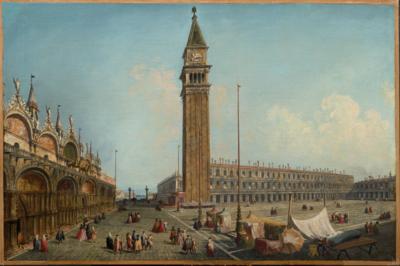Michele Marieschi

(Venice 1696–1743)
Piazza San Marco from the Torre dell’Orologio, Venice,
oil on canvas, 55.8 x 83.7 cm, framed
Provenance:
possible sale, Christie’s, Duncroft Villa, 1 August 1786, lot 59 (as ‘A view of St. Mark’s place at Venice Marieschi’);
possibly sold to Hancock;
Collection of Marquesses of Lothian, Newbattle Abbey/Dalkeith House, Scotland;
thence by descent, until 1950;
with Maison d’Art, Montecarlo;
Private European collection
Literature:
D. Succi, Michele Marieschi. Opera completa, Pordenone 2016, pp. 182-83, no. 19, illustrated p. 179 (as Michele Marieschi)
The present painting shows Piazza San Marco from the Torre dell’Orologio, one of the most iconic views of Venice. On the right is the church of San Basso, with its seventeenth-century façade designed by Baldassarre Longhena. This building was later destroyed during the Napoleonic era. The left-hand side of the composition is dominated by the imposing Basilica of Saint Mark. Marieschi devoted a great deal of attention to the architectural rendering of the buildings, traced with a clear and precise drawing and later completed with fluid brushstrokes. Succi has suggested dating this work to circa 1738.
Little is known of Marieschi’s artistic training and details of his early life remain sparse. He was the son of an engraver who died when Michele was only ten years old. Eighteenth-century sources mention an apprenticeship in Germany; however, this cannot be confirmed. He was certainly influenced by the production of Gaspare Diziani, who was also a witness at his wedding. The work of his maternal grandfather, Antonio Meneghini, also played an important part in Marieschi’s training: Meneghini was a painter who specialised in stage and set design and worked with the Venetian entrepreneur Francesco Tasso on ephemeral decorations for festivals and ceremonies.
Tasso involved Marieschi in the Shrove Thursday celebrations of 1731, and in 1735, commissioned him to design the funeral decorations in honour of Maria Clementina Sobieski, wife of Charles James Edward Stuart, the Pretender to the English throne. Engravings testify to the young Marieschi’s attention to the scenographic rendering of spaces, a characteristic that was also present in all his later vedute. Other characteristics of Michele Marieschi’s style are a skilful and dramatic use of light and an attention to the picturesque details of everyday life.
Between the eighteenth and nineteenth centuries, Marieschi’s vedute enjoyed great popularity amongst British collectors, for their lively and spontaneous character. Works by the Venetian artist entered the collections of the Earls of Devon, Lord Northwick, the Marquess of Lansdowne and, as in the case of this painting, the Marquess of Lothian.
Esperto: Mark MacDonnell
 Mark MacDonnell
Mark MacDonnell
+43 1 515 60 403
oldmasters@dorotheum.com
09.11.2022 - 17:00
- Stima:
-
EUR 300.000,- a EUR 400.000,-
Michele Marieschi
(Venice 1696–1743)
Piazza San Marco from the Torre dell’Orologio, Venice,
oil on canvas, 55.8 x 83.7 cm, framed
Provenance:
possible sale, Christie’s, Duncroft Villa, 1 August 1786, lot 59 (as ‘A view of St. Mark’s place at Venice Marieschi’);
possibly sold to Hancock;
Collection of Marquesses of Lothian, Newbattle Abbey/Dalkeith House, Scotland;
thence by descent, until 1950;
with Maison d’Art, Montecarlo;
Private European collection
Literature:
D. Succi, Michele Marieschi. Opera completa, Pordenone 2016, pp. 182-83, no. 19, illustrated p. 179 (as Michele Marieschi)
The present painting shows Piazza San Marco from the Torre dell’Orologio, one of the most iconic views of Venice. On the right is the church of San Basso, with its seventeenth-century façade designed by Baldassarre Longhena. This building was later destroyed during the Napoleonic era. The left-hand side of the composition is dominated by the imposing Basilica of Saint Mark. Marieschi devoted a great deal of attention to the architectural rendering of the buildings, traced with a clear and precise drawing and later completed with fluid brushstrokes. Succi has suggested dating this work to circa 1738.
Little is known of Marieschi’s artistic training and details of his early life remain sparse. He was the son of an engraver who died when Michele was only ten years old. Eighteenth-century sources mention an apprenticeship in Germany; however, this cannot be confirmed. He was certainly influenced by the production of Gaspare Diziani, who was also a witness at his wedding. The work of his maternal grandfather, Antonio Meneghini, also played an important part in Marieschi’s training: Meneghini was a painter who specialised in stage and set design and worked with the Venetian entrepreneur Francesco Tasso on ephemeral decorations for festivals and ceremonies.
Tasso involved Marieschi in the Shrove Thursday celebrations of 1731, and in 1735, commissioned him to design the funeral decorations in honour of Maria Clementina Sobieski, wife of Charles James Edward Stuart, the Pretender to the English throne. Engravings testify to the young Marieschi’s attention to the scenographic rendering of spaces, a characteristic that was also present in all his later vedute. Other characteristics of Michele Marieschi’s style are a skilful and dramatic use of light and an attention to the picturesque details of everyday life.
Between the eighteenth and nineteenth centuries, Marieschi’s vedute enjoyed great popularity amongst British collectors, for their lively and spontaneous character. Works by the Venetian artist entered the collections of the Earls of Devon, Lord Northwick, the Marquess of Lansdowne and, as in the case of this painting, the Marquess of Lothian.
Esperto: Mark MacDonnell
 Mark MacDonnell
Mark MacDonnell
+43 1 515 60 403
oldmasters@dorotheum.com
|
Hotline dell'acquirente
lun-ven: 10.00 - 17.00
old.masters@dorotheum.at +43 1 515 60 403 |
| Asta: | Dipinti antichi I |
| Tipo d'asta: | Asta in sala con Live Bidding |
| Data: | 09.11.2022 - 17:00 |
| Luogo dell'asta: | Wien | Palais Dorotheum |
| Esposizione: | 22.10. - 09.11.2022 |
